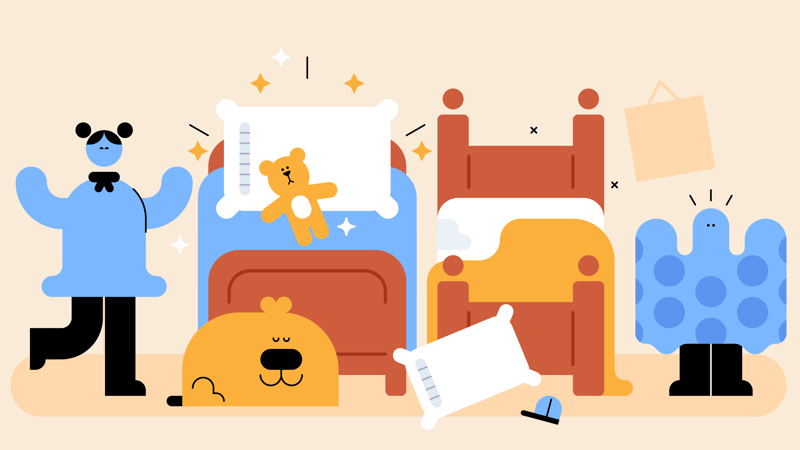
Bed making relay
You’ll need
- Tables
- Two single duvets
- Two single fitted sheets
- Cushions
- Cuddly toys
Before you begin
- Set up tables about the same size as a single bed – set up two single ‘beds’. You may need to push together a few tables to make a big enough ‘bed’.
Learn to make a bed
- The person leading the activity should ask if anyone makes their bed at home. They should also ask if anyone knows why it’s good to make your bed. It helps to keep your bedroom tidy, and it also means your bed is ready to sleep in when it’s bedtime. Making your bed is also important when you change your sheets to wash them.
- The person leading the activity should explain that the tables are pretend beds. They should choose someone to demonstrate how to make a bed, while they call out the ‘Instructions to make a bed’.
- Everyone should watch carefully. If they have any questions, they should ask the person leading the activity at the end of the demonstration.
- Everyone should share one reason why it’s good to know how to make a bed with the person next to them.
Instructions to make a bed
Some people may have different parts to their bed (for example, a top sheet) but this is a general guide.
- Put the fitted sheet over the bed and smooth it down.
- Put one or two pillows (or cushions) at the top of the bed.
- Put the duvet over the bed, and match up each corner of the duvet with each corner of the bed.
- Arrange any extra cushion or cuddly toys neatly on the bed.
Ready to race
- Everyone should split into two teams.
- Each team should practice making their bed, then take everything off again.
- Once they’re confident with all of the steps to make a bed, each team should line up in pairs a little way away from their bed.
- The person leading the activity should give each group a single fitted sheet, some pillows (or cushions), a duvet, and some cuddly toys.
- The person leading the activity should say go, and the first pair should run to the bed with the fitted sheet. They should put the fitted sheet on neatly, then run back to their team. When they get back, they should gently tap hands with the next pair.
- The next pair should run to the bed with the pillows, put them on, and run back to gently tap hands with the next pair.
- The next pair should do the same with the duvet, and the final pair with the cuddly toys. If the groups are bigger, a final pair could do a quality check and make everything as neat as possible.
- The first team to complete all the steps and make their bed is the winner – but only if the person leading the activity says their bed is near enough!
Wash time
- The person leading the game should ask everyone when people need to take everything off a bed (and take pillows and duvets out of their cases). Beds need to be stripped for washing!
- Each team should help take the sheet off their bed. They should take the pillowcases and duvet cover off of the pillows and duvet.
- Everyone should fold the sheets up ready to pack away, and celebrate their new skill.
Reflection
This activity gave everyone a chance to see how quick and easy making a bed can be. Hopefully it also put a bit of fun into an everyday chore! Does anyone already make their bed in the morning? Do they have any tips for everyone else? Once you’ve had a bit of practice, making your bed is just an everyday thing in the morning that doesn’t take long at all. Can anyone think of a tune to hum or sing as they make their bed? Maybe the theme from Mission Impossible, or a favourite superhero film, would work. Now they’ve learned the ropes, everyone could try making their bed at home (maybe even every day) and report back next time you meet.
Safety
All activities must be safely managed. You must complete a thorough risk assessment and take appropriate steps to reduce risk. Use the safety checklist to help you plan and risk assess your activity. Always get approval for the activity, and have suitable supervision and an InTouch process.
- Active games
The game area should be free of hazards. Explain the rules of the game clearly and have a clear way to communicate that the game must stop when needed. Take a look at our guidance on running active games safely.
For an extra challenge, try putting the pillowcases on the pillows (or even the dover cover on the duvet). You could do it as part of the relay, or separately. People may need to work in bigger teams (for example, of four people) and try different methods like reaching into the corners or rolling up the cover and slipping it over. Have fun seeing what works and what doesn’t.
You could pair people up so anyone who needs extra support is with a friend who is able and willing to help.
All Scout activities should be inclusive and accessible.
People could keep a diary to show when they make their bed at home – their parents and carers could check and help them fill it in. Remind the adults that the finished bed might not look as neat as when an adult does it: it doesn’t matter if it’s a bit wonky or wrinkly, the important thing is that people gave it a go and did their best. Try not to make ‘improvements’ to people’s efforts – they’ll get better with time. A camp or sleepover is a great chance for everyone to practice making their bed. A leader could check every day.

